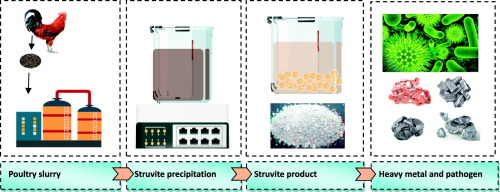Science of the Total Environment ( IF 8.2 ) Pub Date : 2018-04-12 , DOI: 10.1016/j.scitotenv.2018.04.129 Atif Muhmood , Shubiao Wu , Jiaxin Lu , Zeeshan Ajmal , Hongzhen Luo , Renjie Dong

|
The aim of this study was to assess the potential of struvite precipitation to recover nutrients from anaerobically-processed poultry slurry and struvite's interactions with heavy metals (Zn, Cu, Pb, Cr, and Ni) and pathogens (total coliforms and Escherichia coli). The impacts of pH, Mg, N, and P molar proportion, reaction time, and mixing rate and duration were explored to determine the optimal conditions for nutrient recovery through struvite precipitation. A pH range of 9.5 to 10.5, was ideal for P and N removal and recovery, with a molar ratio of 1:1:1 for Mg:N:P. A mixing rate of 150 rpm for 10 min could allow nutrient recovery with little loss (3.32%) of NH₃ through volatilization, and also achieve an optimal struvite crystal size (50–60 μm). The results of X-ray diffractometry and scanning electron microscopy confirmed that the precipitates generated at pH 9 and 10 were orthorhombic struvite. Moreover, along with the recovery of nutrients, 40, 45, 66, 30, and 20% of Zn, Cu, Pb, Cr, and Ni, respectively, and 70% total coliforms and E. coli were removed by struvite precipitation from poultry slurry. This was observed despite that the levels of contaminants (heavy metals) detected in struvite were well below the permissible limits and free of pathogens. Consequently, it was inferred that the struvite quality was reasonable by virtue of its heavy metal and pathogen content, and therefore appropriate for application in the field. Similarly, struvite precipitation has multiple benefits as it can effectively recover nutrients as well as reducing pathogenic populations.
中文翻译:

通过鸟粪石从厌氧消化的鸡粪中回收营养:性能优化以及与重金属和病原体的相互作用
本研究的目的是评估鸟粪石沉淀中,回收从厌氧处理的家禽浆料营养素的电位和鸟粪石的与重金属(锌,铜,铅,铬和镍)和病原体(总大肠菌群和相互作用大肠埃希氏菌)。探讨了pH,Mg,N和P摩尔比,反应时间以及混合速率和持续时间的影响,以确定通过鸟粪石沉淀回收营养的最佳条件。pH值为9.5至10.5,非常适合去除和回收P和N,Mg:N:P的摩尔比为1:1:1。150 rpm的混合速率10分钟可以使营养物回收,并且通过挥发损失很少的NH little(3.32%),并且还可以达到最佳的鸟粪石晶体尺寸(50–60) 微米)。X射线衍射和扫描电子显微镜的结果证实,在pH 9和10下产生的沉淀物是正交晶型鸟粪石。此外,随着营养的恢复,分别有40%,45%,66%,30%和20%的Zn,Cu,Pb,Cr和Ni以及70%的总大肠菌群和大肠杆菌从鸟粪中通过鸟粪石沉淀除去。尽管在鸟粪石中检测到的污染物(重金属)水平远低于允许的极限并且没有病原体,但仍可以观察到。因此,推断鸟粪石的质量由于其重金属和病原体含量是合理的,因此适用于该领域。同样,鸟粪石沉淀物具有多种好处,因为它可以有效地回收养分并减少致病菌种群。


















































 京公网安备 11010802027423号
京公网安备 11010802027423号